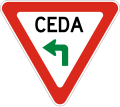Draft:Road signs in Central America
Road signs in Central American countries such as Guatemala, Honduras, El Salvador, Nicaragua, Costa Rica and Panama (except Belize) are regulated by the Manual Centroamericano de Dispositivos Uniformes para el Control del Transito, a Central American equivalent to the United States' MUTCD published by the Central American Integration System (SICA).[1][2] As a result, road signs used in Central American countries are, in most ways, similar in design to road signs used in the United States, except that the metric system is used; for example, speed limits are measured in kilometers per hour. Of the SICA countries, only Costa Rica has signed the 1968 Vienna Convention on Road Signs and Signals.[3]
The first edition of the Manual Centroamericano de Dispositivos Uniformes para el Control del Transito was published in 2000 and most recently updated in 2014.
Regulatory signs
[edit]Regulatory signs are used to indicate to the driver about the priority of passage, the existence of certain limitations, prohibitions and restrictions in the use of the road, according to the traffic laws and regulations of each country.
-
R-1-1
Stop sign -
R-1-2
Give way -
R-1-3
Give way (red right arrow) -
R-1-4
Give way (green turn left arrow) -
R-1-5
Pedestrian priority -
R-1-6
Railway or tram crossing -
R-1-7
Right lane -
R-1-8
Tram crossing plaque -
R-2-1
Maximum speed limit -
R-2-2
Vehicle speed limit -
R-2-3
Night speed limit -
R-2-4
Fog speed limit -
R-2-5
25 KPH plaque -
R-2-7
Maximum and minimum speed limit -
R-2-9
Restricted speed ahead -
R-2-10
If you see one (arrow symbol), restricted speed applies -
R-3-1b
No straight through -
R-3-2a
No entry -
R-3-2b
Wrong way -
R-3-13
Left turn only (right if reversed) -
R-4-1
Controlled entry -
R-6-8
Keep right (left if reversed) -
R-7-14b
No pedestrian crossing -
II-1-7b
Bicycle Route number -
II-2-1
Junction -
4 lanes movement
-
4 lanes movement
Warning signs
[edit]-
P-1-1
Sharp curve to the right (left if reversed) -
PP-1-1
Sharp curve to the right (left if reversed) -
P-1-2
45 degree right curve (left if reversed) -
P-1-3
Sharp reverse curve right (left if reversed) -
P-1-4
Double curve (first to right) (left if reversed) -
P-1-5
Winding road ahead -
P-1-6
Curve ahead -
P-1-7
Direction large arrow right sign (left if reversed) -
P-1-8
Direction large arrow left-right sign -
P-1-9
Chevron sign -
P-1-10
Exit speed advisory sign -
P-1-11
Ramp speed advisory sign -
P-1-12
Advisory exit ramp speed sign -
P-1-13
Trucks may tip over on curve sign -
P-1-14
30 KPH plaque -
P-2-1
Crossroads -
P-2-2
Offset side road intersection -
P-2-3
Side road on the right (left if reversed) -
P-2-4
Skewed side road -
P-2-5
T-intersection -
P-2-6
Y-intersection -
P-2-7
Side road junction on a curve (outside) sign (right) (left if reversed) -
P-2-8
Intersection ahead -
P-3-1a
Stop sign ahead (symbol sign) -
P-3-1b
Stop sign ahead (text sign) -
P-3-2a
Yield sign ahead (symbol sign) -
P-3-2b
Yield sign ahead (text sign) -
P-3-3
Traffic signals ahead -
PP-3-3
Traffic signals ahead -
P-3-4
Roundabout ahead -
P-9-1
Pedestrian crossing -
P-9-7
Residental area -
P-9-10
Bicycle crossing
References
[edit]- ^ "Manual Centroamericano de Dispositivos Uniformes para el Control del Transito 2014" (PDF) (in Spanish). SIECA. Retrieved 3 January 2024.
- ^ "Catálogo de Señales Manual SIECA 2000" (PDF). sjnavarro.files.wordpress.com (in Spanish). 2000.
- ^ "United Nations Treaty Collection". treaties.un.org. Retrieved 27 December 2023.



























































